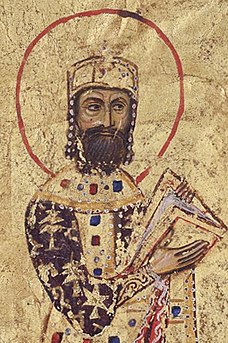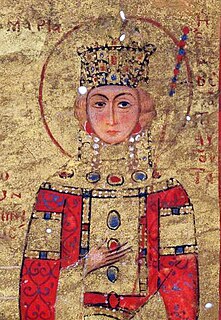 W
WThe Byzantine Empire was ruled by emperors of the Komnenos dynasty for a period of 104 years, from 1081 to about 1185. The Komnenian period comprises the reigns of five emperors, Alexios I, John II, Manuel I, Alexios II and Andronikos I. It was a period of sustained, though ultimately incomplete, restoration of the military, territorial, economic and political position of the Byzantine Empire.
 W
WAlexios I Komnenos, Latinized Alexius I Comnenus, was Byzantine emperor from 1081 to 1118. Although he was not the founder of the Komnenian dynasty, it was during his reign that the Komnenos family came to full power. Inheriting a collapsing empire and faced with constant warfare during his reign against both the Seljuq Turks in Asia Minor and the Normans in the western Balkans, Alexios was able to curb the Byzantine decline and begin the military, financial, and territorial recovery known as the Komnenian restoration. The basis for this recovery were various reforms initiated by Alexios. His appeals to Western Europe for help against the Turks were also the catalyst that likely contributed to the convoking of the Crusades.
 W
WAdrianos Komnenos was a Byzantine aristocrat and general, and a younger brother of the Byzantine emperor Alexios I Komnenos.
 W
WAlexios Komnenos, latinised as Alexius Comnenus, was the eldest son of the Byzantine emperor John II Komnenos and his wife Eirene of Hungary. He was born in February 1106 at Balabista in Macedonia, was made co-emperor with his father at 16 or 17 years of age and died on 2 August 1142 at Attalia, Pamphylia. He was an elder brother of the emperor Manuel I Komnenos, and had a twin sister, Maria Komnene.
 W
WAlexios Komnenos was a Byzantine aristocrat and courtier. A son of Andronikos Komnenos and nephew of Emperor Manuel I Komnenos, he rose to the high rank of prōtostratōr in 1167. In 1176 he participated in the Myriokephalon campaign where, following the death of his older brother John, he was raised to the titles of prōtosebastos and prōtovestiarios. Following Manuel's death in 1180, he won the favour, and reportedly became the lover, of Empress-dowager Maria of Antioch. Through her he ruled the Byzantine Empire for two years as de facto regent of the underage emperor Alexios II Komnenos. The aristocracy challenged his dominance, led by the princess Maria Komnene, who plotted to assassinate the prōtosebastos. The plot was discovered and most conspirators arrested, but Maria and her husband fled to the Hagia Sophia, protected by Patriarch Theodosios Borradiotes and the common people of Constantinople.
 W
WAlexios II Komnenos, Latinized Alexius II Comnenus, was Byzantine emperor from 1180 to 1183. He ascended to the throne as a minor. For the duration of his short reign, the imperial power was de facto held by regents.
 W
WThe Andronikashvili, sometimes known as Endronikashvili (ენდრონიკაშვილები), was a countly family in Georgia who claimed descent from emperor Andronicos I of the Eastern Roman Empire and played a prominent role in political, military and religious life of Georgia. After the Russian annexation of Georgia (1801), the Andronikashvili were confirmed in the dignity of knyaz Andronikov in 1826.
 W
WAndronikos I Komnenos, usually Latinized as Andronicus I Comnenus, was Byzantine Emperor from 1183 to 1185. He was the son of Isaac Komnenos and the grandson of the emperor Alexios I.
 W
WAnna Komnene, commonly Latinized as Anna Comnena, was a Byzantine princess, scholar, physician, hospital administrator, and the first female historian. She was the daughter of the Byzantine emperor Alexios I Komnenos and his wife Irene Doukaina. She is best known for her attempt to usurp her brother, John II Komnenos, and for her work on The Alexiad, an account of her father's reign.
 W
WThe Battle of Beroia was fought in 1122 between the Pechenegs and the Byzantine Empire under Emperor John II Komnenos in what is now Bulgaria. The Byzantine army won the battle, resulting in the disappearance of the Pechenegs as a distinct, independent people.
 W
WConstantine Komnenos was a Byzantine aristocrat and nephew of Emperor Alexios I Komnenos. Promoted to the rank of sebastos, he served as doux of Beroea in 1107, and later as megas droungarios. He married a lady issued from the Antiochos and Euphorbenos clans.
 W
WThe Byzantine Empire experienced several cycles of growth and decay over the course of nearly a thousand years, including major losses during the Arab conquests of the 7th century. However, modern historians generally agree that the start of the empire's final decline began in the 11th century.
 W
WIrene Doukaina or Ducaena was a Byzantine Empress by marriage to the Byzantine emperor Alexios I Komnenos, and the mother of the emperor John II Komnenos and of the historian Anna Komnene.
 W
WThe Battle of Haram or Chramon was fought between the forces of King Stephen II of Hungary and Emperor John II Komnenos of the Byzantine Empire in the year 1128, or possibly earlier – in 1125, in what is now Serbia, and resulted in a major defeat for the Hungarians.
 W
WSaint Irene of Hungary, born Piroska, was a Byzantine empress by marriage to John II Komnenos. She is venerated as a saint.
 W
WIsaac Komnenos or Comnenus was a notable Byzantine aristocrat and military commander in the 1070s. Isaac played a major role in the rise to the throne of his younger brother, the Byzantine Emperor Alexios I Komnenos, and remained a leading figure in his brother's administration until his death.
 W
WIsaac Komnenos or Comnenus was the third son of Byzantine Emperor Alexios I Komnenos and Empress Irene Doukaina. He was raised to the high rank of sebastokrator by his older brother John II Komnenos in reward for his support, but they later fell out, as Isaac began to covet the throne.
 W
WIsaac Doukas Komnenos was a claimant to the Byzantine Empire and the ruler of Cyprus from 1184 to 1191. Contemporary sources commonly call him the Emperor of Cyprus. He lost his empire to Richard the Lionheart during the Third Crusade.
 W
WIsaac I Komnenos or Comnenus was Byzantine Emperor from 1057 to 1059, the first reigning member of the Komnenian dynasty.
 W
WJohn Komnenos was a Byzantine aristocrat and military leader. The younger brother of Emperor Isaac I Komnenos, he served as Domestic of the Schools during Isaac's brief reign (1057–59). When Isaac I abdicated, Constantine X Doukas became emperor and John withdrew from public life until his death in 1067. Through his son Alexios I Komnenos, who became emperor in 1081, he was the progenitor of the Komnenian dynasty that ruled the Byzantine Empire from 1081 until 1185, and the Empire of Trebizond from 1204 until 1461.
 W
WJohn II Komnenos or Comnenus was Byzantine emperor from 1118 to 1143. Also known as "John the Beautiful" or "John the Good" (Kaloïōannēs), he was the eldest son of Emperor Alexios I Komnenos and Irene Doukaina and the second emperor to rule during the Komnenian restoration of the Byzantine Empire. John was a pious and dedicated monarch who was determined to undo the damage his empire had suffered following the Battle of Manzikert, half a century earlier.
 W
WThe Byzantine army of the Komnenian era or Komnenian army was the force established by Byzantine emperor Alexios I Komnenos during the late 11th/early 12th century, and perfected by his successors John II Komnenos and Manuel I Komnenos during the 12th century. From necessity, following extensive territorial loss and a near disastrous defeat by the Normans of southern Italy at Dyrrachion in 1081, Alexios constructed a new army from the ground up. This new army was significantly different from previous forms of the Byzantine army, especially in the methods used for the recruitment and maintenance of soldiers. The army was characterised by an increased reliance on the military capabilities of the immediate imperial household, the relatives of the ruling dynasty and the provincial Byzantine aristocracy. Another distinctive element of the new army was an expansion of the employment of foreign mercenary troops and their organisation into more permanent units. However, continuity in equipment, unit organisation, tactics and strategy from earlier times is evident. The Komnenian army was instrumental in creating the territorial integrity and stability that allowed the Komnenian restoration of the Byzantine Empire. It was deployed in the Balkans, Italy, Hungary, Russia, Anatolia, Syria, the Holy Land and Egypt.
 W
WThe Komnenian restoration is the term used by historians to describe the military, financial, and territorial recovery of the Byzantine Empire under the Komnenian dynasty, from the accession of Alexios I Komnenos in 1081 to the death of Andronikos I Komnenos in 1185. At the onset of the reign of Alexios I, the empire was reeling from its defeat by the Seljuk Turks at the Battle of Manzikert in 1071. The empire was also being threatened by the Normans of Robert Guiscard, who were invading the Balkans from their base in southern Italy. All this occurred as the empire's military institution was in disarray and had grown increasingly reliant on mercenaries. Previous emperors had also squandered the large gold deposits of Constantinople, so the defense of the empire had broken down, and there were few troops to fill the gaps.
 W
WManuel Komnenos was a Byzantine aristocrat and military leader, the oldest son of John Komnenos and brother of the future emperor Alexios I Komnenos. A relative by marriage of Emperor Romanos IV Diogenes, he was placed in charge of expeditions against Turkish raids from 1070, until his sudden death by illness in April 1071.
 W
WManuel I Komnenos, Latinized Comnenus, also called Porphyrogennetos, was a Byzantine Emperor of the 12th century who reigned over a crucial turning point in the history of Byzantium and the Mediterranean. His reign saw the last flowering of the Komnenian restoration, during which the Byzantine Empire had seen a resurgence of its military and economic power, and had enjoyed a cultural revival.
 W
WManuel Erotikos Komnenos was a Byzantine military leader under Basil II, and the first fully documented ancestor of the Komnenos dynasty. His origin and parentage is obscure. He is only mentioned in the sources as leading the defence of Nicaea in 978 against the rebel Bardas Skleros, and as an imperial envoy to him 11 years later. He had three children, late in life. The eldest, Isaac, became emperor in 1057–1059, and the youngest, John, was the progenitor of the Komnenian dynasty as the father of Alexios I Komnenos.
 W
WMaria Komnene or Comnena was the second wife of King Amalric I of Jerusalem and mother of Queen Isabella I of Jerusalem.
 W
WMaria of Antioch (1145–1182) was a Byzantine empress by marriage to Byzantine Emperor Manuel I Komnenos, and regent during the minority of her son porphyrogennetos Alexios II Komnenos from 1180 until 1182.
 W
WNikephoros Komnenos was a Byzantine military leader under the emperors Basil II and Constantine VIII. He served as governor of the Armenian region of Vaspurakan, and is one of the first known members of the Komnenos family, which came to rule the Byzantine Empire in 1081–1185.
 W
WThe Battle of Sirmium, Battle of Semlin or Battle of Zemun was fought on July 8, 1167 between the Byzantine Empire, and the Kingdom of Hungary. The Byzantines achieved a decisive victory, forcing the Hungarians to sue for peace on Byzantine terms. The battle consolidated Byzantine control of the western Balkans.
 W
WTheodora Komnene, Latinized Theodora Comnena, was a daughter of the Byzantine prince Andronikos Komnenos and his wife, Eirene (?Aineiadissa). Based on the writings of Niketas Choniates, it is likely Theodora was Andronikos' second daughter. The year of Theodora's birth is unknown.
 W
WTheodora Komnene or Comnena was a niece of Byzantine emperor Manuel I Comnenus, and wife of King Baldwin III of Jerusalem.